Attractions Nearby Juliaca, Day Trips and Excursions
(Juliaca, Puno, Peru)
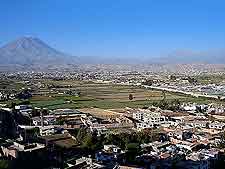
Lying to the far south of
Peru and close to the border of Bolivia, Juliaca is surrounded by a number of small villages, places of interest and historical importance. Many of the most visited attractions are based around
Lake Titicaca, with the city of Puno standing out and being especially close to Juliaca.
However, if you are planning to travel a little further, perhaps around the Puno region, then you simply must head northwards when some truly exceptional and world-class attractions await. Must-sees north of Juliaca include the lost Inca city of
Machu Picchu, and close by,
Cusco, which remains one of the more popular cities in Peru, boasting a tremendous tourist appeal and a host of archaeological ruins.
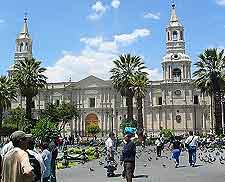
Arequipa
The history of Arequipa is one of earthquakes and volcanic activity, and with a population of around 750,000 people, this city is actually the second-biggest in the whole of Peru, after only
Lima. Arequipa lies to the west of Juliaca and is famous for its exceptional colonial character and magnificent
attractions, many of which are constructed using almost white volcanic rock. Those visiting Arequipa should take a stroll around the Monasterio de Santa Catalina convent, the
Iglesia de la Compania, and the
Museo de Arte Virreinal de Santa Teresa, before climbing up the
El Misti volcano and enjoying the splendid views.
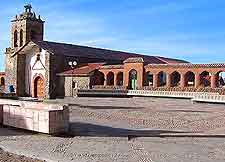
Chucuito
The village of Chucuito is easy to reach and is located to the south-east of Juliaca, where it is roughly 20 km / 12 miles from Puno. Chucuito is ideally suited for day trips and most tourists come here to see its principal attraction, the Templo de la Fertilidad (Temple of Fertility). All around the Templo de la Fertilidad are tall stone phalluses, some of which are more than 1 metre / 3 feet in height and make for a very unexpected sight. This is certainly one place where you will be pleased you brought your camera! Close by, you may also like to explore Chucuito's two colonial-style churches, the Nuestra la Senora and the Santo Domingo.
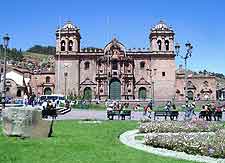
Cusco
Cusco is ideally sited for those intending to pay a visit to
Machu Picchu or the
Sacred Valley, or planning a trek along the famed
Inca Trail. Cusco is situated to the north of Juliaca and is one city not to miss. Once the very heart of the Inca Empire, the city of Cusco is surrounded by many wondrous and ancient sites, with the heart of the city being based around the squares of
Plaza de Armas, Plaza Regocijo and Plaza San Francisco.
Museums are particularly plentiful here and tend to have a strong Inca flavour as you would expect.
Cutimbo
Cutimbo is to the south of Juliaca and around 20 km / 12 miles from Puno. The location of Cutimbo is extremely special, since is lies at the very top of a volcano hill, where it is completely surrounded by verdant plains. Cutimbo's attractions include a series of ancient 'chullpas' (stone funerary towers), which are believed to date back to the civilisations of the Collas, the Incas and also the Lupacas. Although this location is fairly hard to reach, it is well worth exploring, although you are strongly recommended to travel in groups due to its remoteness.
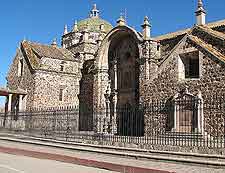
Lampa
Lampa is an especially charming and appealing town, and is to the north-west of Juliaca, where it is often referred to as the Pink City (La Ciudad Rosada), due to its wealth of soft, pink-coloured structures and buildings. There are a number of very eye-catching attractions standing within Lampa, such as the beautiful Iglesia de la Inmaculada church and the unusual catacombs beneath. Also possibly of interest are Lampa's small Museo Kampac and the nearby prehistoric carvings at the Cueva de los Toros.
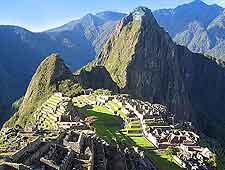
Machu Picchu
Machu Picchu is often referred to as the 'Lost City of the Incas' and is without question the ultimate Peru experience and attraction. The spectacular setting of Machu Picchu is nothing short of breathtaking, and these ancient Inca ruins are open from dawn until dusk, being at its busiest between the hours of 10:00 and 14:00. Machu Picchu is to be found to the north of Juliaca and due to its relevant proximity, is certainly one excursion that you simply must make. Inside the ruins, look out for the
Temple of the Sun, the Royal Tomb, the Sacred Plaza, the Principal Temple and the House of the High Priest, amongst other extraordinary sights.
Open hours: daily - dawn to dusk
Admission: charge, discount available to students and children, children eight years old and under are free, limited visitor numbers to 2,500 per day, 5-days minimum advanced booking is recommended
Matarani
The lively city of Matarani is to the south-west of both Juliaca and Arequipa, where it enjoys an oceanfront setting and serves as a busy and important port. Attractions in Matarani tend to be coastal in their nature, although most tourists usually to come to this particular spot to catch a boat or cruise liner.
Pucara
Pucara is located around 60 km / 37 miles to the north-west of Juliaca are can therefore be reached in around an hour, making it perfect for a day trip. Although Pucara is a rather sleepy town, is does contain some worthy attractions relating to the area's pre-Inca site, which is known to be connected to the Tiahuanaco civilisation. These interesting ruins stand just above Pucara and are a short walk away, being accompanied by an on-site museum displaying various relics and anthropomorphic monoliths from the actual site.
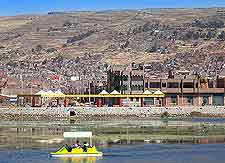
Puno
The port city of Puno lies alongside Lake Titicaca and directly to the south of Juliaca. Many tourists visit Puno each day, along with its surrounding archaeological attractions and ancient sites. However, the main reason for coming to Puno is usually to enjoy a boat trip around the lake, visiting the islands and appreciating the shoreline from a distance. Within Puno itself, sights include its Baroque-style cathedral, the 17th-century Casa del Corregidor, Huajsapata Park, and a number of museums, such as the Museo Carlos Dreyer and the Museo Naval.
 Lying to the far south of Peru and close to the border of Bolivia, Juliaca is surrounded by a number of small villages, places of interest and historical importance. Many of the most visited attractions are based around Lake Titicaca, with the city of Puno standing out and being especially close to Juliaca.
Lying to the far south of Peru and close to the border of Bolivia, Juliaca is surrounded by a number of small villages, places of interest and historical importance. Many of the most visited attractions are based around Lake Titicaca, with the city of Puno standing out and being especially close to Juliaca.




